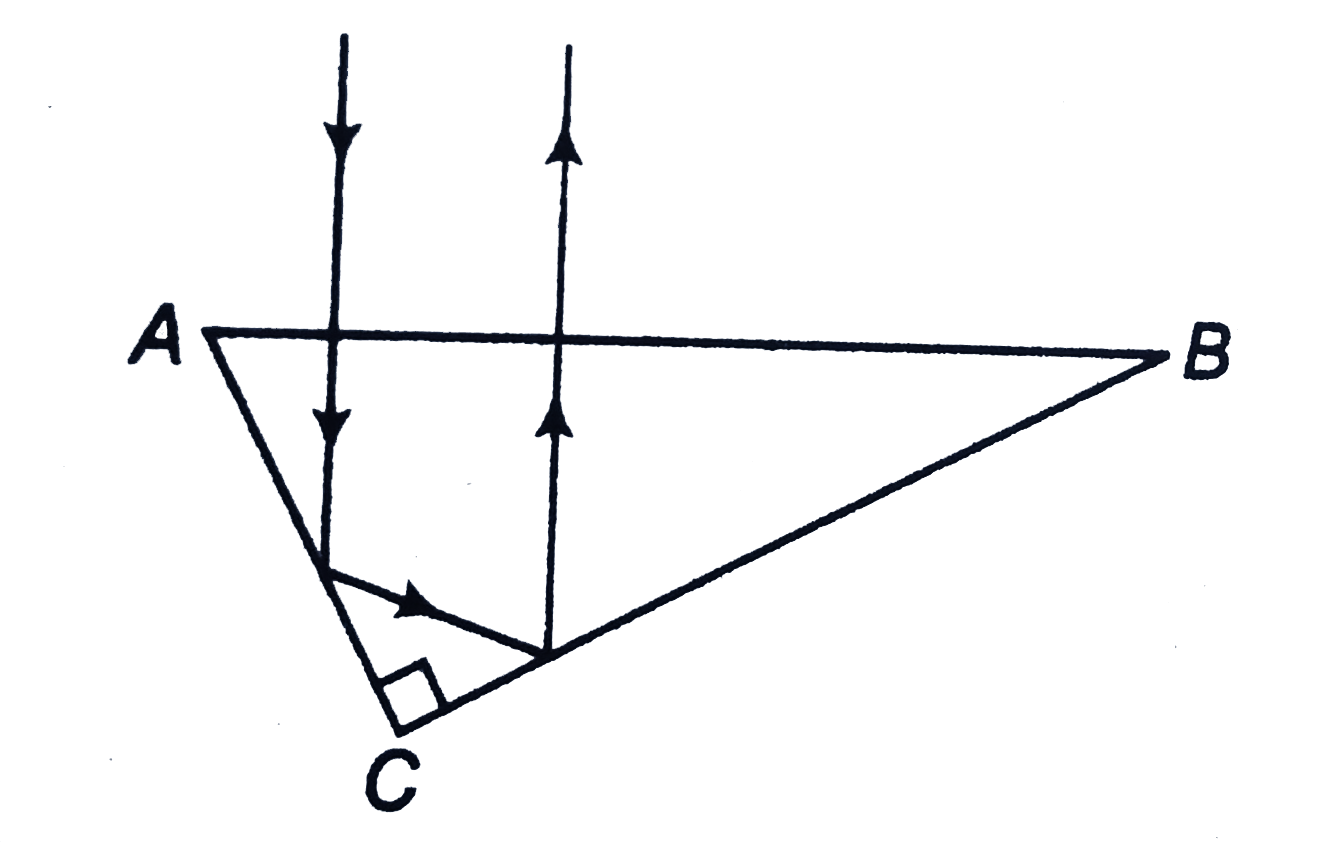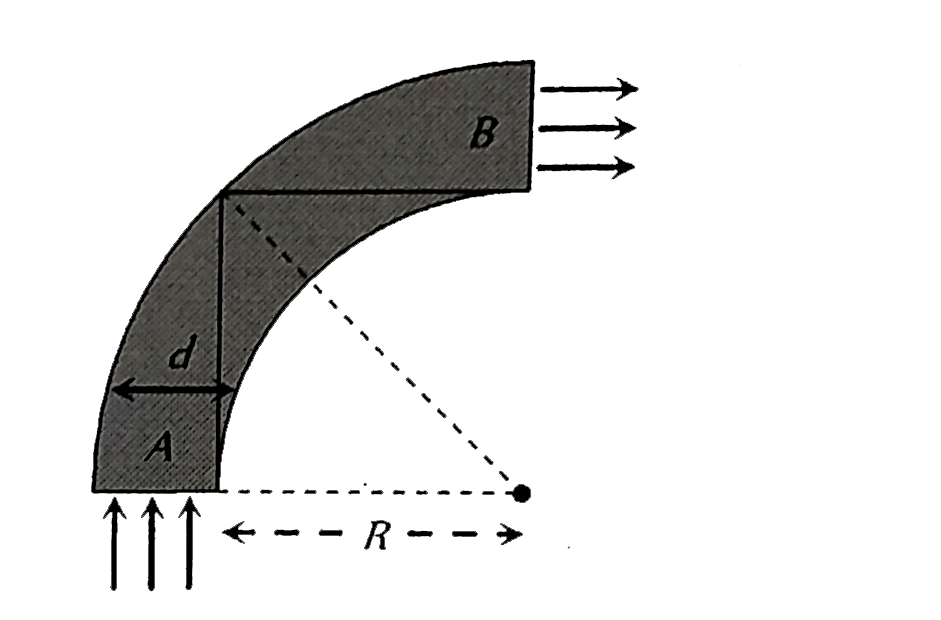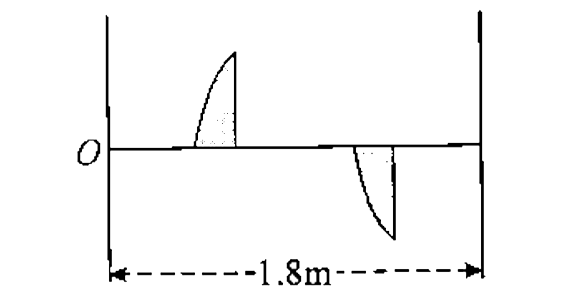Complete Solutions to Problems of chapter RAY OPTICS of Class 12 book with complete answers and questions
| Class 12 | PHYSICS |
| Chapter | RAY OPTICS |
| SL ARORA | Problems |
| Number Of Questions | 26 |
| Academic Year | 2023-24 |
Screen S is illuminated by two point sources A and B. Another source C sends a parallel beam of light towards point P on the screen (see figure). Line AP is normal to the screen and the lines AP, BP and CP are in one plane. The distance AP, BP and CP are 3m, 1.5m and 1.5m respectively. The radiant powers of sources A and B are `90` watts and `180` watts respectively. The beam from C is of intensity `20`(watts)`/(m^2)`. Calculate the intensity at P on the screen. `

View SolutionA motor car is fitted with a convex driving mirror of focal length `20 cm`. A second motor car is `6 m` away from the driving mirror of the first car. Calculate (i) position of second car as seen in the first car mirror.
(ii) if the second car is overtaking the first car at a relative speed of `15 m//s`, how will its image be moving and in what direction ?
View SolutionGlycerine (refractive index 1.4) is poured into a large jar of radiys 0.2m to a depth of 0.1m. There is a small light source at the centre of the bottom of the jar. Find the area of the surface of glycerine through which the light passes.
View SolutionA point source of light `S` is placed at the bottom of a vessel containing a liquid of refractive index `5//3`. A person is viewing the source from above the surface. There is an opaque disc of radius `1 cm` floating on the surface. The centre of disc lies vertically above the source `O`. The liquid from the vessel is gradually drained out through a tap. What is the maximum height of the liquid for which the source cannot be seen at all.
View SolutionA ray of light travelling in glass `(mu_g=3//2)` is incident on a horizontal glass-air surface at the critical angle `theta_C.` If a thin layer of water `(mu_w=4//3)` is now poured on the glass-air surface. At what angle will the ray of light emerges into water at glass-water surface?
View SolutionA rectangular glass block of thickness 10 cm and refractive index 1.5 placed over a small coin. A beaker is filled with water of refractive index `4//3` to a height of 10 cm and is placed over the glass block.
(a) Find the apparent position of the object when it is viewed at near normal incidence.
(b) if the eye is slowly moves away from the normal at a certain position, the object is found to disappear, due to total internal reflection. At what surface does this happen and why ?
View SolutionA ray of light travelling in air is incident at grazing angle (incident angle=`90^(@))` on a long rectangular slab of a transparent medium of thickness `t=1.0` (see figure). The point of incidence is the origin `A(O,O)` .The medium has a variable index of refraction n(y) given by :`n(y)=[ky^(3//2)+1]^(1//2)` ,where k=`1.0m^(-3//2)`.the refractive index of air is 1.0`

(i) Obtain a relation between the slope of the trajectory of the ray at a point `B(x,y)`in the medium and the incident angle at that point
(ii) obtain an equation for the trajectory `y(x)`of the ray in the medium.
(ii) Determine the coordinates (`x_(1),y_(1))` of the point `P`.where the ray the ray intersects upper surface of the slab -air boundary.
Indicate the path of the ray subsequently.
View SolutionA right angled prism is to be made by selecting a proper material and the angles A and B `(B <= A), as shown in figure. It is desired that a ray of light incident on the face AB emerges parallel to the incident direction after two internal reflections.

(a) What should be the minimum refractive index n for this to be possible?
(b) For `n=5/3` is it possible to achieve this with the angle B equal to `30` degrees?
View SolutionA right angles prism `(45^(@),90^(@), 45^(@))` of refractive index n has a plate of refractive index `(n_(1)ltn)` cemented to its diagonal face. The assembley is in air. A ray is incident on AB.
a. Calculate the angle of incidence at AB for which the ray strikes the diagonal face at the critical angle.
b. Assuming `n=1.351`, calculate the angle of incidence at AB for which the refracted rey passes through the diagonal face undeviated.

View SolutionLight is incident at an angle `alpha` on one planar end of a transparent cylindrical rod of refractive index `mu`. Determine the least value of `mu` so that the light entering the rod does not emerge from the curved surface of rod irrespective of the value of `alpha` `

View SolutionA rod of glass `( mu = 1.5)` and of square cross section is bent into the shape shown in the figure. A parallel beam of light falls on the plane flat surface A as shown in the figure. If d is the width of a side and R is the radius of circular arc then for what maximum value of `(d)/(R)` light entering the glass slab through surface A emerges from the glass through B

View Solution
A slab of a material of refractive index 2 shown in fig. has a curved surface APB of radius of curvature 10 cm and a plane surface CD. On the left of APB is air and on the right CD is water with refractive indices as given in the figure. An object O is placed at a distance of 15 cm from the pole P as shown. The distance of the final image of O from P, as viewed from the left is......
View SolutionA parallel beam of light travelling in water (refractive index ` =4//3)` is refracted by a spherical air bublle of radius 2mm situated in water. Assuming the light rays to be paraxial,
a. Find the position of image due to refraction at first surface and position of the final image.
b. Draw a ray diagram showing the position of both images.
View SolutionA glass sphere of radius 5 cm has a small bubble at a distance 2 cm from its centre.The bubble is viewed along a Diameter of the sphere from the side on which it lies.How far from the surface will it appear.Refractive index of glass is 1.5
2.5 cm behind the surface
View SolutionA plano-convex lens has thickness 4cm. When places on a horizontal table with the curved surface in contact with it, the apparent depth of the bottom-most point of the lens if found to be 3cm. If the lens is inverted such that the plane face is in contact with the table, the apparent depth of the center of the plane face of the lens is face of the lens is found to be `25//8` cm. Find the focal length of the lens.
View SolutionTwo point light sources are 24 cm apart. Where should a convex lens of focal length 9 cm be put in between them from one source so that the images of both the sources are formed at the same place
View SolutionA convex lens and a convex mirror of radius of curvature `20 cm` are placed co-axially with the convex mirror placed at a distance of `30 cm` from the lens. For a point object at a distance of `25 cm` from the lens, the final image due to this combination coincides with the object itself. What is the focal length of convex lens ?
View SolutionConsider a coaxial system of two thin convex lenses of focal length f each separated by a distance d. Draw ray diagrams for image formation corresponding to an object at infinity placed on the principal axis in the following cases: (a) `d lt f`,(b)`d=f`, (c ) `f lt d lt 2f`, (d) `d=2f`, and (e) `d gt 2f`. Indicate the nature of the combination (concave, convex or plane) in each case.
View SolutionA thin plano-convex lens of focal length f is split into two halves. One of the halves is shifted along the optical axis as shown in figure. The separation between object and image planes is 1.8 m. The magnification of the image, formed by one of the ball lens is 2. Find the focal length of the lens and separation between the two halves. Draw the ray diagram for image formation.

View SolutionTwo thin similar convex glass are joined together front to front, with its rear portion silvered such that a sharp image is formed `0.2m` for an object at infinity. When the air between the glass pieces is replaced by water `(mu=4/3),` find the position of image.
View SolutionThe redius of curvature of the convex face of a plano-convex lens is 12cm and its refractive index is 1.5.
a. Find the focal length of this lens. The plane surface of the lens is now silvered.
b. At what distance form the lans will parallel rays incident on the convex face converge?
c. Sketch the ray diagram to locate the image, when a point object is places on the axis 20cm from the lens.
d. Calculate the image distance when the object is placed as in (c).
View SolutionThe convex surface of a thin concavo-convex lens of glass of refractive index 1.5 has a radius of curvature 20 cm. The concave surface has a radius of curvature 60 cm. The convex side is silvered and placed at horizontal surface as shown in figure.
(i) Where should a pin be placed on the optic axis such that its image is formed at the same place ?
(ii) If the concave part is filled with water of refractive index 4/3, find the distance through which the pin should be moved so that the image of the pin again coincide with pin.

View SolutionA small fish, 0.4m below the surface of a lake, is viewed through a simple converging lens of focal length 3m. The lens in kept at 0.2m above the water surface such that the fish lies on the optical axis of the lens. Find the image of the fish seen by the observer. The refractive index of water is `4//3`.
View SolutionA ray of light is incident at an angle of `60^@` on the face of a prism having refracting angle `30^@.` The ray emerging out of the prism makes an angle `30^@` with the incident ray. Show that the emergent ray is perpendicular to the face through which it emerges and calculate the refractive index of the material of prism.
View SolutionA `60^(@)` prism has a refractive index of `1.5`. Calculate (a) the angle of incidence for minimumdeviation (b) angle of minimum deviation ( c) the angle of emergence of light at maximum deviation (d) angle of maximum deviation.
View SolutionA prism of refractive index `n_(1)` & another prism of reactive index `n_(2)` are stuck together without a gap as shown in the figure.The angle of the prisms are as shown. `n_(1)&n_(2)`depend on`lambda`,the wavelength of light according to `n_(1)=1.20+(10.8xx10^(4))/(lambda^(2)) & n_(2)=1.45+(1.80xx10^(4))/(lambda^(2))` where `lambda` is in nm.

(i)Calculate the wavelength `lambda_(0)`for which rays incident at any angle on the interface`BC`pass through without bending at that interface.
(ii) for light of wavelength `lambda_(0)`,find the angle of incidencei on face`AC`such that the deviation produced by the combination of prism is minimum.
View Solution
Problems questions and complete solutions for chapter RAY OPTICS of DHANPAT RAI & CO PHYSICS (HINGLISH) of Class 12